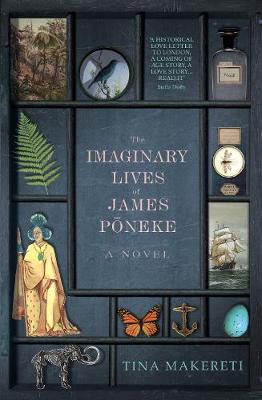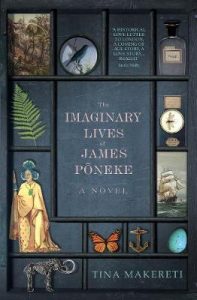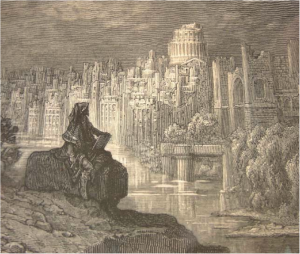
The Indigenous Literature Reading Group met on August 21st 2020 to discuss Makereti’s 2018 novel (https://www.waterstones.com/book/the-imaginary-lives-of-james-poneke/tina-makereti/9781785631528)
Chloe Osborne writes:
 Loosely based on the real life story of a Maori boy who travelled to London under the auspices of an artist to appear as an exhibit in the Victorian Egyptian Hall, Makereti’s novel follows the movements of Hemi, otherwise known as James, as he traverses the globe navigating a multiplicity of diverse nineteenth-century cultures and communities. Predominantly set in London, Makereti explores through the eyes of Hemi the strange dynamics of the Victorian metropolis, its public centre and its underbelly, its heavyweights and its outcasts. The Indigenous Literature Reading group’s discussions of the novel centred around the experiences of the protagonist, in particular the ways he symbolises the experience of exotic encounters by Indigenous peoples in Britain at that moment in history, as well as the contemporary take on sexual and gender politics that Makereti significantly infuses into the narrative. Whilst the decision to explore queer themes through the character of Hemi was considered by the group an exciting choice, it was felt that perhaps Makereti had attempted to do too much by way of plot in such a short novel. She brilliantly subverts notions of the Victorian gaze and exotic performativity through her depiction of the life of James, whose narration consistently turns the imperial object/subject dialectic on its head. Through Hemi’s experiences of London, she further subverts the essentially Victorian literary trope of atavism – ‘going troppo’ – with her portrayal of an indigenous Maori who must learn the (often savage seeming) ways of the natives in order to understand the exotic world he lands in in London. These are big themes that require nuanced handling, and Makereti excels at highlighting the incredible anachronisms of the imperial project through her protagonist’s narrative. On top of this, Makereti tackles the hefty topics of nineteenth-century homoeroticism through her depiction of Hemi and Billy’s relationship, subversive gender politics through her cross-dressing Henry, and the horrors of slavery in the final chapters where Hemi finds himself shipwrecked in Barbados. The group discussed this extraordinarily wide thematic scope, and considered her play with genre, through which she both evoked and resisted tropes of the Victorian novel.
Loosely based on the real life story of a Maori boy who travelled to London under the auspices of an artist to appear as an exhibit in the Victorian Egyptian Hall, Makereti’s novel follows the movements of Hemi, otherwise known as James, as he traverses the globe navigating a multiplicity of diverse nineteenth-century cultures and communities. Predominantly set in London, Makereti explores through the eyes of Hemi the strange dynamics of the Victorian metropolis, its public centre and its underbelly, its heavyweights and its outcasts. The Indigenous Literature Reading group’s discussions of the novel centred around the experiences of the protagonist, in particular the ways he symbolises the experience of exotic encounters by Indigenous peoples in Britain at that moment in history, as well as the contemporary take on sexual and gender politics that Makereti significantly infuses into the narrative. Whilst the decision to explore queer themes through the character of Hemi was considered by the group an exciting choice, it was felt that perhaps Makereti had attempted to do too much by way of plot in such a short novel. She brilliantly subverts notions of the Victorian gaze and exotic performativity through her depiction of the life of James, whose narration consistently turns the imperial object/subject dialectic on its head. Through Hemi’s experiences of London, she further subverts the essentially Victorian literary trope of atavism – ‘going troppo’ – with her portrayal of an indigenous Maori who must learn the (often savage seeming) ways of the natives in order to understand the exotic world he lands in in London. These are big themes that require nuanced handling, and Makereti excels at highlighting the incredible anachronisms of the imperial project through her protagonist’s narrative. On top of this, Makereti tackles the hefty topics of nineteenth-century homoeroticism through her depiction of Hemi and Billy’s relationship, subversive gender politics through her cross-dressing Henry, and the horrors of slavery in the final chapters where Hemi finds himself shipwrecked in Barbados. The group discussed this extraordinarily wide thematic scope, and considered her play with genre, through which she both evoked and resisted tropes of the Victorian novel.
As a Victorianist researcher, I was particularly interested in exploring the possible connection between Makereti’s narrative and the recurring Victorian figure of ‘The New Zealander’, a Maori traveller to a post-imperial London in ruins. This famous image, which symbolised the fallibility of empire, was first conjured by the British historian, writer and politician Thomas Babington Macaulay, who wrote ‘And she [meaning the Catholic Church] may still exist in undiminished vigour when some traveller from New Zealand shall, in the midst of a vast solitude, take his stand on a broken arch of London Bridge to sketch the ruins of St Paul’s’.[1] 32 years later, the book, London: A pilgrimage(Blenchard Jerrold) illustrated by Gustave Doré, included as the last of its 180 images that of “the New Zealander” perched on Thames rock sketching the ruins of London. He is regarding the ruins of an earlier civilisation just as an English noble might have done on his ‘grand tour’.
The grand tour was a ‘rite of passage’ for young wealthy Englishmen, particularly in the eighteenth and early-nineteenth centuries, to tour parts of Europe to finish off their education. The ruins of Rome and Greece (and occasionally further afield in Asia) were often the target of the tour. Describing his first glimpse of London on what might be considered his own ‘grand tour’, Hemi significantly spots through the fog the golden orb atop the dome of St Paul’s, in a moment which crucially posits him as ‘The New Zealander’, come to witness the degeneration of the imperial project even at its apotheosis. It would be fascinating to know whether Macauley’s New Zealand was an inspiration for Makereti, with Hemi a temporally displaced witness to the beginning of imperial ruination.
[1]http://www.literarylondon.org/london-journal/march2004/skilton.html

The New Zealander, Gustave Doré
Bio
Chloe Osborne is a PhD Researcher at Royal Holloway, University of London. Her thesis examines the interplay between Pacific literature and anthropology in the nineteenth and early-twentieth centuries.
Our next meeting will be on October 2nd and we will be discussing Stephen Graham Jones’s The Only Good Indians. If you’d like to join in (via zoom), email David Stirrup: dfs@kent.ac.uk